Sampling Accessories Used for Microscope Measurement
The ability to obtain high-quality spectra with infrared microscope measurement depends, to a large extent, on the efficacy of the technique used to obtain samples. Even if high-performance devices are used, it may not be possible to obtain the required information if the sampling method is unsuitable. In order to perform sampling effectively, the minimum requirement of accessories must be prepared beforehand and the analyst must be able to use them effectively. Here, I will describe the minimum accessory requirement and extra accessories that may be useful.
1. Minimum Accessory Requirement
Stereo Microscope
Infrared microscope measurement often involves the measurement of samples with dimensions of less than 100 µm, and stereo microscopes are required to check the samples. The ideal type of stereo microscope is the binocular type with an adjustable magnification factor in the single-digit to two-digit range. Recently, microscopes incorporating digital cameras and digital CCD systems that can be attached to microscope tubes have become commercially available.
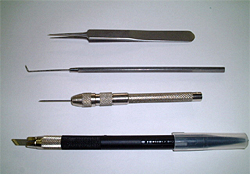
Fig. 1 Sampling Tools
Sampling Tools
3-piece sets consisting of precision tweezers, precision needles, and precision knives, which are required for sampling foreign substances, are available. Tools with sharper ends are more suitable for obtaining smaller samples. Precision needles are available in sizes such as 1 µm and 5 µm, and it is convenient to use needles that can be held in a holder and changed when necessary. It is recommended that the necessary tools are purchased together with reference to laboratory-instrument catalogs.
When cutting out a thin section of a sample in order to perform transmission measurement, as thin a blade as possible is used. A safety razor or a stainless-steel replacement microtome blade is suitable.
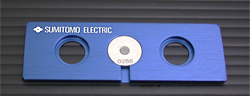
Fig. 2 Diamond Window
Transmission Window
In order to measure samples using the transmission method, they must be placed on transmission windows. KBr or BaF2 windows of diameter 13 mm and thickness 2 mm are often used. KBr is relatively inexpensive but is prone to scratching. It is also deliquescent and has a low resistance to water and so the BaF2 window is more suitable in cases where water-resistance is required. Diamond windows (see Fig. 2) are available for cases where a high level of durability is required.
2. Useful Accessories
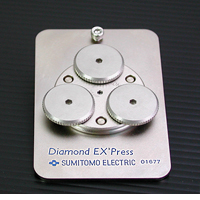
Fig. 3 Diamond Cell
Diamond Cell
A diamond cell consists of two discs into which diamonds with dimensions of 2 to 3 mm are embedded. Samples can be inserted between the discs and compressed. (See Fig. 3.) This accessory is useful for making hard or irregularly shaped samples thinner. After the sample has been compressed with the two discs, measurement is carried out using only the single window to which the sample has adhered. This is in order to reduce the affect of absorption by the diamond and to prevent interference fringes.
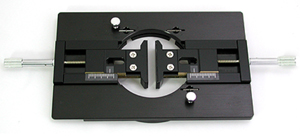
Fig. 4 Micro-Vice Holder
Micro-Vice Holder
When analyzing a sample on a curved surface using microscopic ATR or microscopic reflectance, the analyzed part must be held in a horizontal state. In such cases, a micro-vice holder is a convenient accessory. (See Fig. 4.) For example, when analyzing a foreign substance on the surface of a tablet using ATR, the sample can be turned so that the foreign matter is at the top and then secured in position. This accessory can also be used when analyzing the cross section of bulk samples. Rotation on the stage in the horizontal direction is also possible, making it easy to adjust the angle of the sample for line mapping.
Microtome
There are various types of microtome. The rotary microtome, however, is recommended when performing pretreatment for FTIR. It is used when, for example, cutting out cross sections of multilayered film and analyzing the layers or when analyzing foreign substances contained inside resins. If the sample is small and cannot be held by itself, it must be embedded in epoxy resin or some other appropriate material. There are resins that are specifically used for embedding but epoxy adhesives consisting of two-liquid mixtures can also be used.
A thin section cut at a setting of 10 µm will give an appropriate peak intensity when analyzed using the transmission method. Also, a microtome can be used to cut out a cross section that is suitable for measurement using microscopic ATR.
A description and illustration (Figure 5) of the micro-manipulation system have been deleted from this page, as its production has been discontinued.
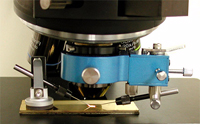
Fig. 6 EZ-Pick
EZ-Pick
Although the micro-manipulation system enables precise manipulation, it is relatively expensive and there are restrictions on the installation location. In contrast, EZ-Pick uses a simple mechanism and is easy to operate. Whereas manipulators control the position of a needle with respect to a fixed sample, EZ-Pick controls the position of a stage holding the sample with respect to a fixed needle. As shown in Fig. 6, the holder with the needle is attached to the objective lens so that the needle tip is visible within the field of view and sampling is performed by moving the stage so that the sample makes contact with the needle tip. The portion of sample that adheres to the needle tip is dropped onto the window by rubbing it against a needle that was fixed to the stage beforehand.
Systems in which EZ-Pick is applied to stereo microscopes are commercially available. (See Fig. 7.) These systems are equipped with software for loading digital images into a PC and scaling functions. The magnification factor is in the two- digit range, making it difficult to extract of foreign substances with dimensions of less than 50 µm.
For more information, contact S.T. Japan Inc.
TEL 81(3)3666-2561
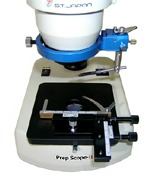
Fig. 7 Prep Scope II
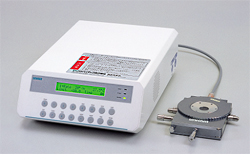
Fig. 8 Microscope Heating/Cooling Unit
Microscope Heating/Cooling Unit
A heating/cooling stage is available to facilitate analysis of the adhesive hardening process or the resin deterioration process that accompanies increases in temperature on the stage of an infrared microscope. (See Fig. 8.) Temperature control is possible between room temperature to 600 °C. A cooling unit and liquid nitrogen are required to perform cooling. Using this unit makes it possible to perform transmission or reflectance measurement based on a specified temperature program with an infrared microscope.
For more information, contact Japan High Tech Co., Ltd.
TEL 81(92)281-7055
3. Summary
Infrared microscopes allow various types of sample measurement using, for example, the transmission method, the reflectance method, or the ATR method. Furthermore, using the accessories described here makes it possible to perform pretreatment more efficiently and expand the range of application.


